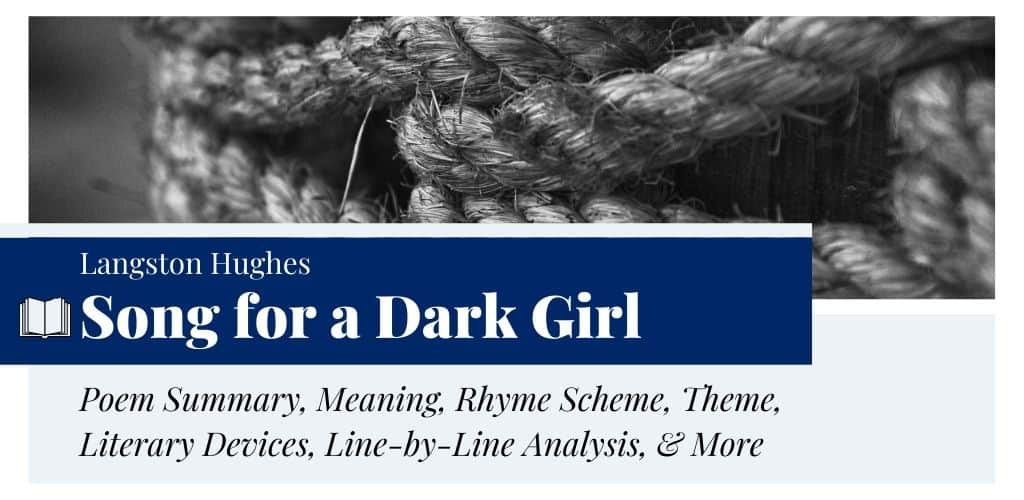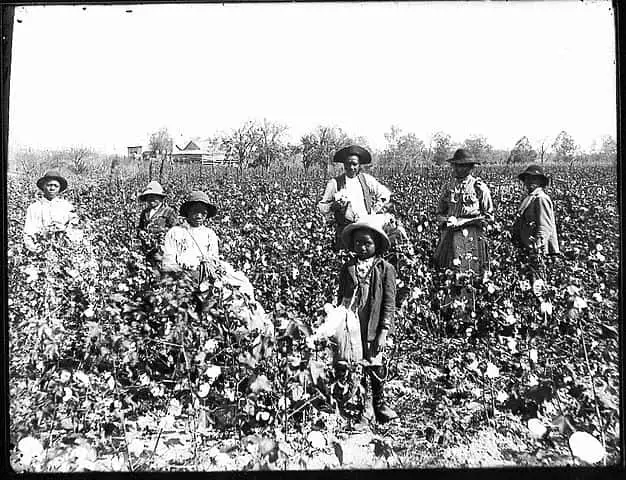Song for a Dark Girl by Langston Hughes
Langston Hughes’ elegy “Song for a Dark Girl” describes the death of a woman’s lover. The speaker describes how her lover has been bruised and hung up on a crossroads tree. This image of the lover that the poet draws upon in this poem is gruesome and akin to the Crucifixion of “white” Jesus Christ. Throughout the poem, the speaker reflects upon her loss and grief. Her impassioned note on the death of her lover captures her broken voice and tortured spirit. Besides, Hughes describes the brutalities against the African-American community during the 1920s through her elegiac note.
- Read the full text of “Song for a Dark Girl” below:
Song for a Dark Girl
by Langston Hughes
Way Down South in Dixie
(Break the heart of me)
They hung my black young lover
To a cross roads tree.
Way Down South in Dixie
(Bruised body high in air)
I asked the white Lord Jesus
What was the use of prayer.
Way Down South in Dixie
(Break the heart of me)
Love is a naked shadow
On a gnarled and naked tree.

Summary
In “Song for a Dark Girl,” Hughes’ poetic persona paints the agony of a black girl who suffers the loss of her lover. The speaker talks about how this incident occurred in the southern state of America; the region is generally known as “Dixie.” She describes how the man, who was of African-American descent, was hung up on the crossroads tree. This incident starts to make her feel her prayers to God are useless. They are not being answered. The scene of his “bruised body high in air” has scarred her so much that she comes to describe love as a “naked shadow/ On a gnarled and naked tree.” In the overall poem, Hughes uses simple yet powerful imagery to express the pain of the speaker and the brutalities against blacks.
Meaning
“Song for a Dark Girl” is about the grief of a woman whose lover was lynched and hung on the cross roads tree. This piece reflects upon a black woman’s sense of loss and piercing agony at seeing how inhumanely they are treated. The speaker’s entire life changes from the point of seeing her lover brutally killed. She talks about how she starts to find that all her prayers are meaningless because God turned his eyes away from her lover. In the end, the speaker compares love to “a naked shadow/ On a gnarled and naked tree,” which represents how much the loss of her lover has distorted her concept of love.
Form, Rhyme Scheme, & Meter
Form
“Song for a Dark Girl” is an elegy with a regular rhyme scheme. The poem has a total of 12 lines, distributed among three quatrains. Each quatrain presents a complete idea and begins with a refrain, “Way Down South in Dixie.” Besides, the poem is written from the first-person point of view, and the overall tone of the poem is grieving, agonized, and regretful. The speaker can be a male or female speaker. From the title, it can be inferred that this poem/song is dedicated to a black girl whose lover was brutally tortured to death. The verses are spoken from the perspective of the girl.
Rhyme Scheme
This piece contains a regular rhyme scheme that alternates across the stanzas. For instance, the rhyme scheme of the first quatrain is AABA. It means the first two lines form a rhyming couplet, and the last line ends with the rhyme of the first two lines. Here, the words “Dixie,” “me,” and “tree” rhyme. The term “lover” breaks the rhyme.
In the second stanza, the rhyme scheme is ACDC. Here, “air” and “prayer” rhyme. The first line ends with the rhyme at the beginning, and the term “Jesus” breaks the synchronicity.
The third stanza ends with a rhyme scheme similar to that of the first stanza. It is AAEA. Hughes uses the exact words for the sake of rhyming and uses “shadow” to break the rhyme.
The presence of a rhyming pattern employs a sing-song-like quality to the poem. Elegies are sung rather than recited. Hence, Hughes this regular rhyming pattern.
Meter
This poem contains a set meter. In each line, there are around six syllables. After grouping them into three metrical feet, one has to stress the syllables according to the mood of the line. Overall, the poem mainly consists of iambic feet. Hence, the poem is in iambic trimeter with a number of variations. For instance, the refrain is in trochaic trimeter, which gives a falling rhythm to the beginning. It perfectly captures the mood of the speaker. Besides, some lines begin with either trochaic or acephalous feet. It also captures the speaker’s topsy-turvy state of mind. The following scansion will give a better idea of the overall metrical scheme of the poem.
Way Down/ South in/ Dix-ie
(Break/ the heart/ of me)
They hung/ my black/ young lov(e)r
To/ a cross/ roads tree.
Way Down/ South in/ Dix-ie
(Bruised bo/-dy high/ in air)
I asked/ the white/ Lord Jes(u)s
What was/ the use/ of pray(e)r.
Way Down/ South in/ Dix-ie
(Break/ the heart/ of me)
Love is/ a na/-ked shad(o)w
On a/ gnarled and/ nak(e)d tree.
Literary Devices
Hughes uses rhetorical devices in order to express the pain and grief of the woman. The literary devices used in the poem are as follows:
- Refrain: The speaker repeats the line “Way Down South in Dixie” to create a flow and emphasize where the event took place. It also stresses how the speaker cannot forget the place.
- Allusion: The first line of each quatrain alludes to the song, “I Wish I Was in Dixie,” often shortened as “Dixie” or “Dixie’s Land.” It originated in the minstrel shows of the 1850s and was adopted as a national anthem of the Confederacy during the American Civil War.
- Aside: Hughes uses this dramatic device once in every quatrain to add details about the woman’s feelings. She says, “Break the heart of me” twice and “Bruised body high in the air.” These lines perfectly assemble how devastating the death of her lover was for her.
- Metaphor: Hughes describes love as “a naked shadow/ On a gnarled and naked tree.” It refers back to how her lover had died. That moment made a lasting image in her mind to the point that it has become synonymous with a “naked shadow.”
- Alliteration: The alliteration of the “b” sound occurs in the phrase “Bruised body.”
- Assonance: The “au” sound is repeated in the refrain, “Way Down South in Dixie.”
- Consonance: It occurs in the repetition of the “n” sound in the line, “On a gnarled and naked tree.” It also occurs in “Dixie/ Break,” “To a cross roads tree,” “gnarled and naked,” etc.
- Imagery: The poem begins with organic imagery (conveys a speaker’s internal feelings and emotions) present in the line, “Break the heart of me.” Hughes uses visual imagery in “They hung my black young lover/ To a cross roads tree.”
Line-by-Line Analysis & Explanation
Lines 1-4
Way Down South in Dixie
(Break the heart of me)
They hung my black young lover
To a cross roads tree.
In the first stanza of “Song for a Dark Girl,” Langston Hughes describes the death of a woman’s lover. The speaker is the “Dark Girl” who grieves her lover’s death. She describes how an incident that occurred in a region of “Dixie,” Southern America, broke her heart. She recalls how “they” hung him on a crossroads tree. The pronoun “they” refers to the white men who killed her lover. Besides, the last line alludes to the episode of Christ’s crucifixion. The tone of this section is sad, agonized, and regretful. The use of the term “black” emphasizes the racial identity of the lover. It hints at how they were treated in the early 20th century as well as in the past.
Lines 5-8
Way Down South in Dixie
(Bruised body high in air)
I asked the white Lord Jesus
What was the use of prayer.
In the second verse, the speaker repeats the line “Way Down South in Dixie.” The speaker recourse to an aside to recall how his bruised body was hung high in the air. After the incident took place, she asked Jesus Christ what was the actual “use” of her prayers if He could not save His black children. The brutalities against African-Americans are not going to fade away. Thus, she finds prayers to the almighty to be meaningless. Her tone in this verse is grief-stricken and desperate as she finds no one else to talk to. On top of that, Christ has stopped listening to her prayers.
Lines 9-12
Way Down South in Dixie
(Break the heart of me)
Love is a naked shadow
On a gnarled and naked tree.
In the last verse, the woman repeats the first two lines of the poem, expressing how she is still right where she started. The incident got her in an emotional loop. Alongside that, the death of her lover has scarred her so much that she sees love to be a dark thing like a “naked shadow.” The light of love has ceased to exist with the death of her lover. Now, everything associated with her lover looks shadowy. Hughes also uses the image of a “gnarled and naked tree” to describe how for the woman, love feels like a knobby gothic tree. The scene of her lover’s bruised body hanging from the tree still haunts her.
Theme
Hughes’ “Song for a Dark Girl” taps on the themes of racism, the loss of a loved one, and grief. In this poem, Hughes describes how a black man was lynched and hung from a tree. He describes the agony of the woman who was in love with him. The incident changed her views on love and humanity forever. She tries to find solace and peace in prayers, but she fails to. Her loneliness and pain are captured in the aside, “Break the heart of me.” Just the remembrance of “Dixie,” where the incident happened, pains her deeply.
The image of the man she loved being bruised and hung in the air from the crossroads tree is similar to the one of Jesus Christ on the Cross. Hughes creates an interspersed piece that includes religion and racism, love and brutality, and belief and hopelessness. These fusions help to convey the girl’s loss.
Historical Context
Langston Hughes, an American poet, novelist, and columnist from Missouri, was a prominent figure of the Harlem Renaissance. His works portray racial consciousness and cultural nationalism free from self-hate. Hughes gives a voice to the African-American community by shedding light on their struggles and grieving through his poems. He promoted pride in being Black and came to be known as a “people’s poet.” He talks about the lynching of a “black young lover” in his poem “Song for a Dark Girl,” published in 1927 at the height of the “New Negro Movement”.
Questions & Answers
“Song for a Dark Girl” by Langston Hughes is a poem about the death of a young woman’s lover, who was lynched to death and hung up on a crossroads tree. This piece describes her grief and scarred memory of the incident.
Hughes’ poems often touch upon racism and give voice to the struggles of African-Americans. The title of this poem is justified since this describes the life of a woman after her lover had been lynched to death. Later, his body was hung on the crossroads tree to carve an example. It describes her struggles and how heartbroken she became after the incident. This song captures the agony of the girl.
This poem was written in 1927 during the height of the New Negro Movement, also known as the Harlem Renaissance. It contains a haunting picture of a black person who was brutally beaten and later hanged from a tree.
This elegy is a lamentation of a girl who lost her lover. The young lover was not a victim of any natural events. Instead, he was lynched for being Black. His death had a lasting impact on the speaker’s mind that not only scarred her soul but also shifted her faith in Christ and love.
Hughes uses a metaphor in the line, “Love is a naked shadow.” Here, love is compared to a bare shadow of all the goodness of humanity. Besides, the term also symbolizes the speaker’s lover who was hung from the “gnarled and naked tree.”
It is an elegy that contains a regular rhyme scheme and meter. The rhyme scheme of the poem is AABA which alternates across the text. Regarding the meter, the poem is composed of the iambic trimeter with a few variations.
The theme of the piece is grief, the loss of a loved one, and racism. This poem captures the agonized voice of a black girl whose lover was beaten to death and hung from a tree.
The tone of the poem is grieving, regretful, hopeless, and ironic. It reflects the mental state of the speaker who had lost her “young lover.”
This line metaphorically hints at the speaker’s lover, who was killed brutally. Like his body which was hung up from a tree, her feeling of love was also tortured that day when “they” (the racists) did so.
This line refers to Christ from the perspective of Blacks. According to the speaker, the religion of Christianity is dominated by whites. However, she put her faith in Christianity or the sacrifice of Christ when her lover was alive. After his death, her belief system collapsed. Now, she thinks all her prayers to the “white Lord” are fruitless, like her plea to the racists who beat her lover to death.
Similar Poems about Racism
- “To a Dark Girl” by Gwendolyn Bennett — This poem is addressed to all the African-American girls in order to evoke a sense of racial consciousness in them.
- “Spiritual Song of the Aborigine” by Hyllus Maris — This piece captures the cultural roots of the indigenous people of Australia.
- “The Black Family Pledge” by Maya Angelou — In this poem, Angelou asks to take a pledge for the betterment of their community.
- “Iron” by Elizabeth Acevedo — This piece was written in response to the depiction of the brutal killings of African-Americans.
External Resources
- Listen to “Song for a Dark Girl” — Listen to the musical version of Hughes’ poem.
- About “I Wish I Was in Dixie” — Learn about the historical significance of the song and read its different versions.
- History of Lynching in America — Read how white Americans used to lynch Black people to terrorize and control them in the 19th and early 20th centuries.
- About Langston Hughes — Learn about the poet’s life and read some of his best-known poems.
- Biography of Langston Hughes — Explore more about the poet’s career and works.



